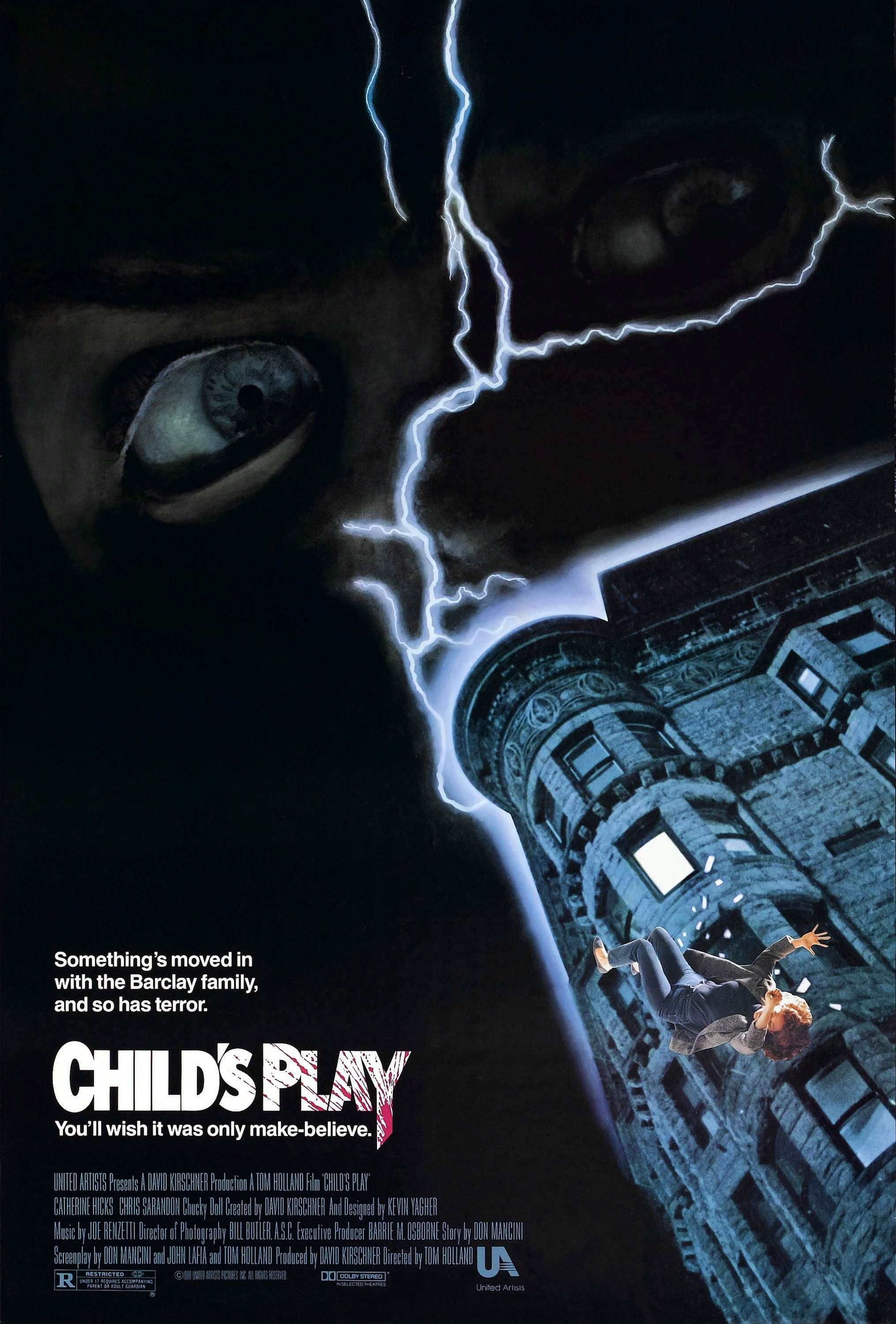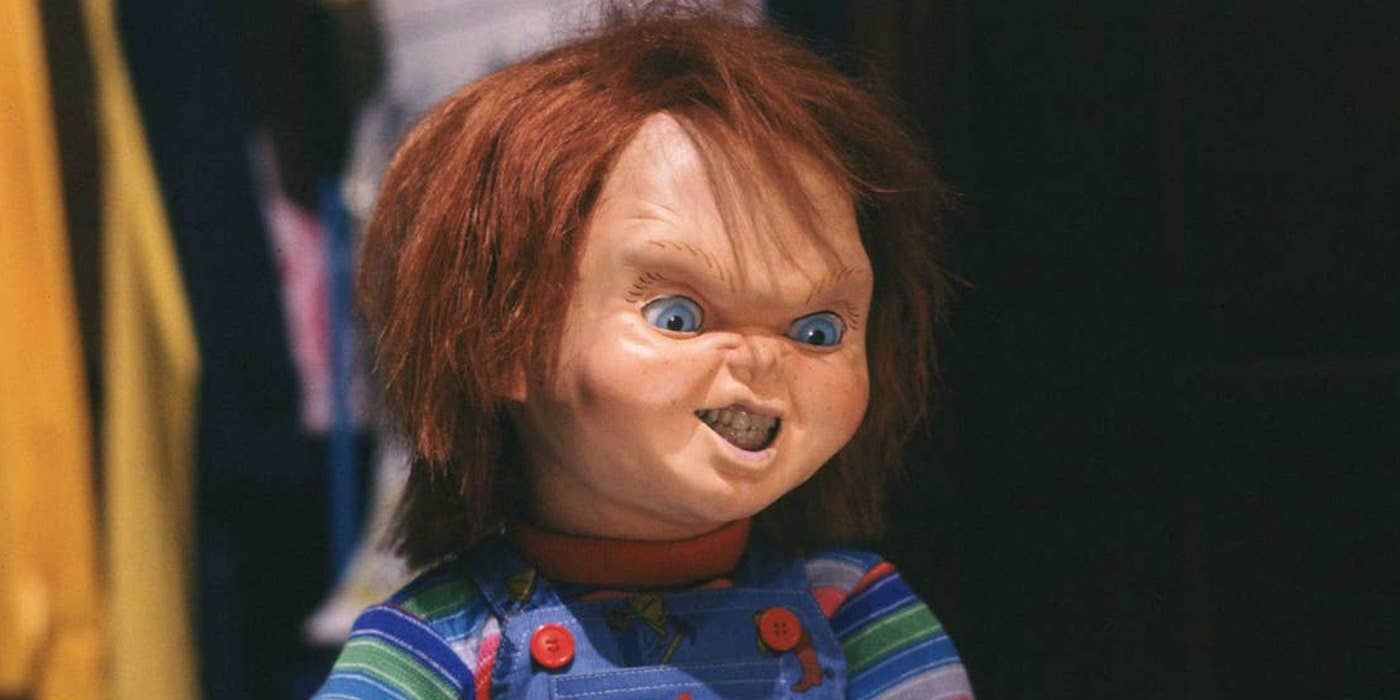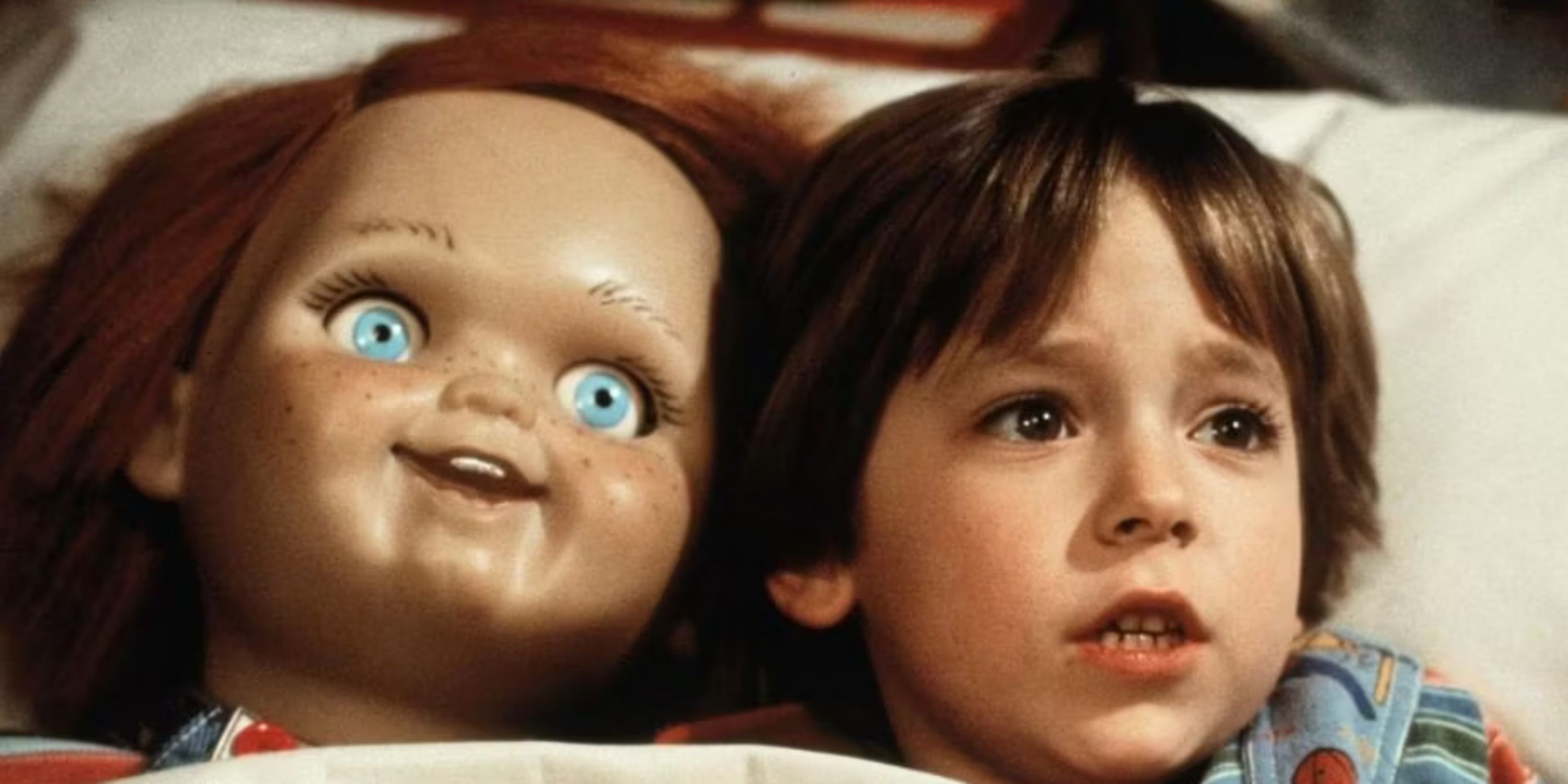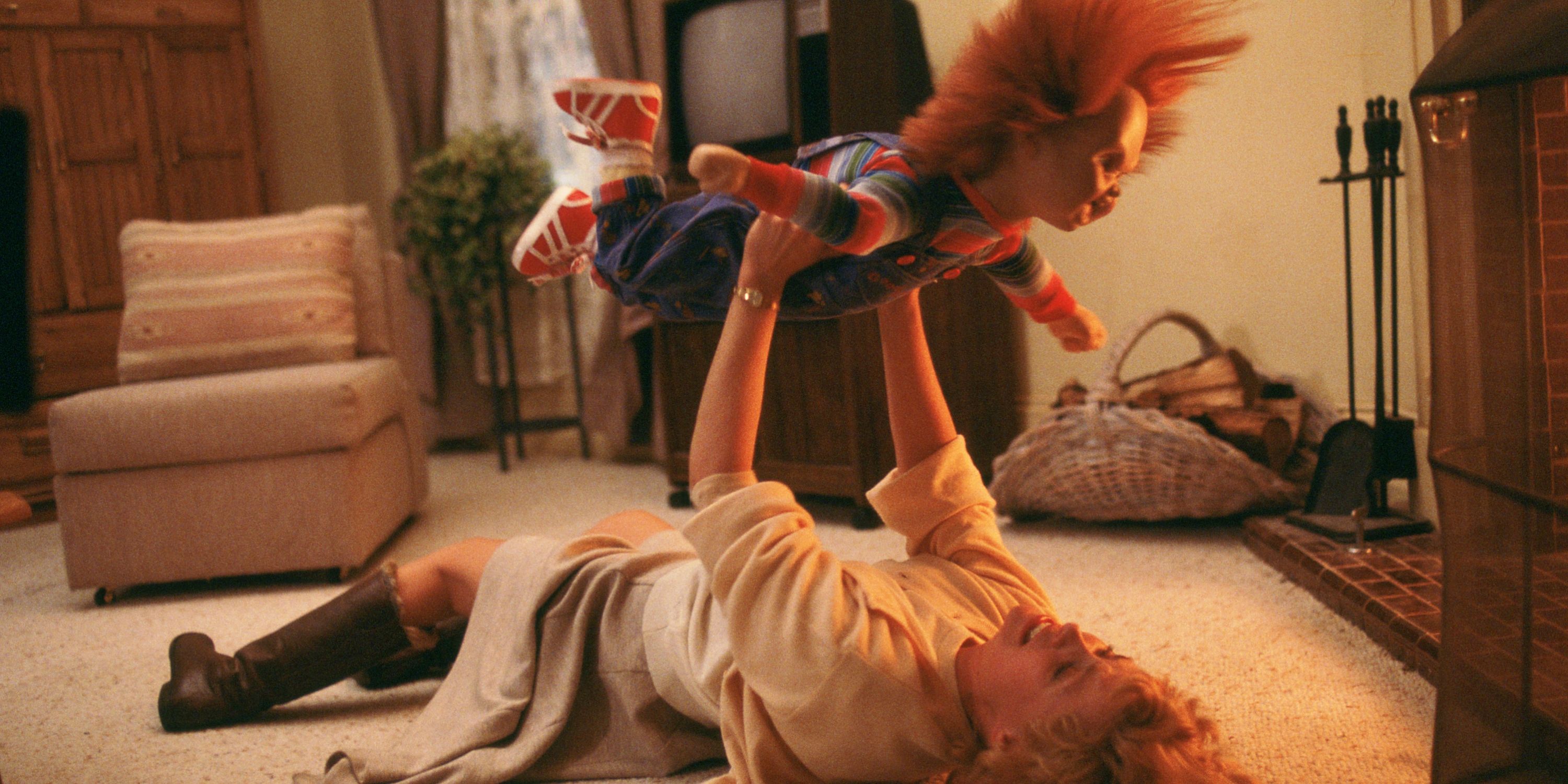The Big Picture
- Chucky, the murderous doll from Child's Play, has become a hugely popular franchise with multiple movies, a TV show, and merchandise.
- The original script for Child's Play, called Blood Buddy, underwent changes before being greenlit for production.
- Producer David Kirschner shares his journey from creating Child's Play to his fear of dolls that inspired the story, as well as the evolution of the franchise and the creation of the iconic Chucky character.
Thirty-five years ago, audiences were introduced to a salty murderous doll, a child’s toy with the consciousness of a very pissed off serial killer trapped within it. Since the release of Child’s Play on November 9, 1988, Chucky – whose full name, Charles Lee Ray, is derived from the names of notorious killers Charles Manson, Lee Harvey Oswald (assassin of John F. Kennedy) and James Earl Ray (assassin of Martin Luther King) – has spawned a franchise that includes several movies, a TV show, and more merchandise than you can imagine.
What started as a script by Don Mancini called Blood Buddy, about a doll that came with a pin so that you could become its blood buddy, turned into a tale about a struggling mother (Catherine Hicks) unknowingly gifting her son (Alex Vincent) a Good Guy doll that a killer (Brad Dourif) on the verge of death used voodoo to transfer his soul into. When producer David Kirschner joined the project, inspired by a lifelong fear of dolls that started with an episode of The Twilight Zone, he made some changes to the Blood Buddy script before John Lafia did a rewrite and Tom Holland signed on to direct, and they were off and running on the start of the hugely popular franchise.
Collider recently got the opportunity to chat 1-on-1 with Kirschner (who has also produced the Hocus Pocus films) about the evolution of Chucky, from that first script and his original drawings of what the doll should look like to everything that’s come since. During the interview, he shared stories about his journey from An American Tail to a killer doll, getting Child’s Play greenlit, how he never even thought about a sequel, let alone everything that’s come since the first film’s release, balancing the beauty and laughter of life with the horror that exists, how the first big reveal of Chucky came about, the fine-tuning the film went through prior to its release, how Dourif ultimately came to voice the sarcastic doll, and all the wild merchandise that’s available.

Child's Play
A struggling single mother unknowingly gifts her son a doll imbued with a serial killer's consciousness.
Director
- Release Date
- November 8, 1988
- Director
- Tom Holland
- Cast
- Catherine Hicks , Chris Sarandon , Alex Vincent , Brad Dourif , Dinah Manoff , Tommy Swerdlow
- Runtime
- 87
- Main Genre
- Horror
Collider: As a producer, is it more nerve-wracking to keep a franchise going, like with Chucky, or is it more nerve-wracking to come back to something many years later, like with Hocus Pocus, and try to find the success and the magic again?
DAVID KIRSCHNER: Both of those. For a little backstory, the reason I did Chucky in the first place, my wife and I had been in London and I bought a book, called The Dollhouse Murders, that I still have in my office. When I was a kid, I watched an episode of The Twilight Zone with my big sister and my big cousin, called “Talky Tina,” and it starred Telly Savalas. It was so scary to me. I was always frightened of my sister’s dolls, but the truth is, I was frightened of everything. I loved watching all the scary stuff during the day, and by night, not only would I pay the price, but my family would as well because every light had to be on in the house and I would have 12 blankets over me in the San Fernando Valley without air conditioning in the sixties. I don’t know why, I just loved it. The whole doll thing and clown thing falls into the same weird category for me. I came back and I gave my development person this book and said, “I would love to do something with a doll.” She said, “Well, there was a screenplay that went out about six months ago, called Blood Buddy.” I said, “Oh, I’d like to read it.” She said, “Well, everybody passed on it.” And I said, “I’m just so curious to see what somebody did with a doll story in a more contemporary form.”
She gave it to me and I really liked an awful lot of it. There were parts of it that did not work at all. In Don [Mancini’s] original script, the doll was made with a red watery substance and it came with a pin, so that you could become a blood buddy with this doll. It didn’t make sense to me that any toy company would put a needle in and you could prick not only your doll’s skin, but more importantly, your own skin. For me, I always needed a Frankenstein moment. What is the thing that brings the creature to life? So, I had come up with the idea of this Lakeshore Strangler who’s on the run and takes refuge in a toy store, and then he [transfers] his body into the doll. Tom Holland, our director, came up with the notion of voodoo, which made it easier for the audience to understand, almost like Catholicism. It’s not that any of it really makes sense to us, but there are all these things that people have been indoctrinated with from the time they were little, and religion fascinates me. Guillermo Del Toro speaks of it so well. He said that so much of his childhood was filled with dead bodies on the street, growing up during civil war. It just fascinated him, the idea of Catholicism, which he practices, and death. In all his work, he has tapped into something like that.
So, with Tom coming up with the voodoo business, that made it that much easier for the audience to assess the fact that there was some kind of magic that brought it to life. In my version, he put his hand on his head and, as he was dying, he transmogrified his soul into the doll and the doll became animated. And then, Chuck is my brother-in-law, who I love dearly and is a wonderful person, but there were three men that terrorized my childhood – Charles Manson, Lee Harvey Oswald and James Earl Ray. That’s where the name Charles Lee Ray came from. Most people don’t know that. So much of what Don created in that script, but ultimately didn’t make it into the film, we used in other iterations. For instance, in Bride of Chucky, there’s a brilliant scene that Don wrote, with Jennifer Tilly being electrocuted as she’s watching The Bride of Frankenstein. It’s so beautiful. Ronny Yu was the director and Peter Pau was the cinematographer, and that scene is so beautifully shot and directed, but it’s everything that Don put down on paper. It was pretty exciting to see that. In the entire franchise, that’s probably my favorite scene. I just love that. Jennifer Tilly is so great in that scene.
How did your career take a turn from being an executive producer and part of creating the story for An American Tail and go from bringing Fievel to the world to Chucky to Hocus Pocus?
KIRSCHNER: It’s a very good question. When I first did Chucky and my mother saw it, she asked the same question. By day, children imagine and pretend and have the most glorious of imaginations. By night, children have the darkest of imaginations. “Dad, mom, there’s a monster under my bed. Close my closet door.” I was that kid. I still get very frightened by many things. Robert Louis Stevenson wrote Treasure Island and was the toast of European society. He then turned around and wrote Strange Case of Dr Jekyll and Mr Hyde and Victorian society wanted him banned because they said women were fainting over just the idea of that story. And then, he turned around and wrote A Child’s Garden of Verses. Walt Disney understood that so well with how he weaved storytelling through his films, of being moved to laughter and tears. There was great horror in those Disney films, specifically the horror of parental loss with Bambi and that gunshot. It continued long after Walt Disney was gone with The Lion King, where Scar pushes his brother off the cliff and you see him falling and dying. It’s horrific. And the Grimms understood that so well, as well.
It was not anything intentional on my part, I just think it’s in my DNA with the stuff that I love. My heroes, when I was growing up, were Walt Disney and Alfred Hitchcock. As strange as that is, I do think that is life. There’s beauty and laughter, but there’s also great horror. I don’t mean that everyone’s family has experienced murder. For instance, I lost my dad when I was really young, and that was a horror for our family. That loss influenced me. Even with An American Tail, at the beginning, Fievel is washed off the ship and they think their son is dead when they come to America with this dream. Of course, in the end, they’re brought back together. That’s an absolute influence of Walt Disney and the Grimms. I have grown daughters and three grandchildren, and every day, my wife and I are like, “When you get somewhere, let us know that you’re okay.” We’re living in a scary world, and it may not be chainsaws and dolls coming to life, but there are scary things that are out there. That’s an outlet for us, and always has been for audiences, with horror.
On paper, the concept of Child’s Play and Chucky seems silly. It seems like there are more reasons that it shouldn’t work than it should. But here we are, it’s a successful franchise that has spanned many movies and a TV series. What were early conversations like, in the beginning, as far as like the hopes of what this could be like? Was there talk of sequels or other things you could do, or would you have thought that was just a crazy idea, at the time?
KIRSCHNER: I never even thought of a sequel. I did Chucky because I really loved an awful lot of Don’s script and I really wanted to prove that I could do something other than animation. An American Tail was my second creation. My first was a very soft little world that Hallmark and the General Mills Toy Group were my partners on, in my early 20s. Kathy Kennedy saw an article on me that said, “Shy young daydreamer brings his dreams to life,” after I created Rose Petal Place, and Jim Henson actually helped me get into Hallmark to present it to them. He made the call for me. So, there was this article on me in the L.A. Times, and Kathy read it and asked to meet with me. Hallmark had passed on An American Tail, and so had Disney. I won’t use his complete language, but Jeffrey Katzenberg said, “Who the F is gonna go see a film about a Jewish mouse?” I said, “Who’s gonna go see a film about a wooden puppet? It’s what you do with that character and the journey that you take them on and the emotional arcs.” And he said, “Thanks anyway.” But he did write me a note saying, “Dear David, now I know who the F is gonna go see a film about a Jewish mouse. Mazel tov!” That was nice of him. That’s how I got Hocus Pocus made.
I had Spielberg pixie dust all over me. But I wanted to prove that I could do something really scary, and Don’s script was the answer for that. John Lafia came in and did a complete rewrite of the first script, but I brought Don back for Child’s Play 2 and Child’s Play 3. When it came to Child’s Play 4, he said to me, “David, I’d like to direct this.” I said, “Look, you’ve not been on the set with me completely, from one end to the other.” I really believed in him. He was clearly very, very talented, and that talent has just grown over the years. I said, “Why don’t you come up to Canada? I’ll make you an executive producer. Live and breathe it and be a part of everything.” He was so instrumental in that film being great. The director left and really didn’t do much of the editing, and so Don and I, and a woman named Corey Sienega that worked with me, sat down and reedited the film.
Don was so great that I just said, “You’re doing the next film,” and that was Seed of Chucky. The gentleman who rewrote Don’s script, John Lafia, was so talented, but sadly took his life a couple of years ago. He directed Child’s Play 2 which, in the fandom of Chucky, is considered to be the one that people say is the best. Everybody has an opinion, but for me, I love Child’s Play and Child’s Play 4. Don has also done such a great job on the television series. He’s a very proud gay man, and he’s woven these characters in, specifically the gay kid in high school and what that was like, and a lot of people, gay or not, relate to that character. Don has just done an amazing job of keeping the franchise going.
Can you talk about the way the reveal came together? When we see Chucky come to life for the first time in Child’s Play, was that how it always played out? Were there lots of conversations about how to make that first reveal work?
KIRSCHNER: Yeah, absolutely, and we did storyboards. It was my first live-action film, and Tom [Holland] was much more of a veteran than I was, but he just kept showing the doll, early on. In my mind, we should have handled it, and we eventually did, like Jaws or Alien. It’s better to pace yourself and have a slow burn, and then reveal it, so we went back in and cut 27 minutes out of Tom’s cut because it tested so poorly. It did not go well. Towards the end, Chucky’s head has been blown off with a gun, and the actor touches it quickly to see if everything is okay, and then he picks it up. At the test screening, it would have been funny if it wasn’t my movie, but someone screamed from the audience, “Don’t touch it! There’ll be a sequel!” And I just remember sliding down in my seat and my dear wife saying, “It’s gonna by okay. You’re gonna fix this.”
And we did. I went back in with Edward Warschilka, who’s a wonderful editor, and I asked Don to come in. Tom had banned Don from the set. He just was annoyed by him, didn’t like him, or whatever it was. After that first cut, the studio got rid of Tom and we went back in and edited it, cut 27 minutes out of it, tested it again, and it tested through the roof. Don’t get me wrong, Tom is very talented and brought a lot to the franchise. Those moments of Chucky coming to life pretty much followed John Lafia’s script and what Don had done, and then Tom took a pass, as well. Honestly, it was Don and John Lafia that really made that script happen, and Tom deserves credit for the voodoo of it all. He also brought Brad Dourif into it, and he’s been part of the family for 35 years.
Obviously, one of the most iconic aspects of Chucky is Brad Dourif’s voice performance, but I read that almost didn’t happen and that there was another actor brought in to voice the character in post-production. And then, thankfully, after test screenings, it went back to being Brad Dourif. When you think back to the moment that decision was made, to go back to Brad Dourif, do you consider yourself and everyone involved with the franchise to be very lucky that that’s how it ended up?
KIRSCHNER: Oh, without a doubt. It was never actually tested, but it was Mercedes McCambridge. She had done voice stuff for The Exorcist, but Tom, especially, felt that it just didn’t work, so he called his friend Brad Dourif, who came in. Brad deserves so much credit because the doll really didn’t say a lot, in Don’s script or even John Lafia’s script. He wasn’t the wise guy that Chucky has become. There was one “F-you” that Brad came up with. It’s a scene in the elevator where an elderly couple are going to visit somebody and they’ve got a tray of food with tinfoil over it. As they’re going up in the elevator, the wife says, “Some kid has left their doll just sitting there,” and she looks at it strangely. And as she gets off the elevator, she says, “That is an ugly doll.” And Brad, just winging it said, “Fuck you!” The audience went crazy. It was just like, “What’s that about?” So, Don jumped on that.
Don is really clever. His dad was in advertising, and I think that blood runs in Don. For Bride of Chucky, the tag line was, “Chucky gets lucky.” And Don had come up with, “Sorry, Jack, Chucky’s back,” with the Jack-in-the-Box and the scissors. Don is just really clever with advertising lines and came up with so much of that. Don’s script, as I said, had been out there and I really wanted to do it, so I rewrote 18 pages, put in this stuff about the Lakeshore Strangler, and did drawings of what Chucky should look like. In Don’s mind, there was a doll that was out, called My Buddy, which was the basis for it. If you’ve seen the yellow boxes, that’s all my original art that I did for that. And then, on his little overalls, there are all these so-called children’s toys, but it’s a baseball bat, a hammer, and things that can be used by Chucky in very nefarious ways.
So, I did my graphite pencil drawings of Chucky, and then I went out and pitched it to studios and had five studios that wanted it. That was really exciting because they had passed on the other version. It’s a funny business of heat-seeking missiles, but the fact that Spielberg had chosen to take my story (for An American Tail) and make it into a film that we would produce together, all of a sudden, in the eyes of the entertainment business, I had some talent and people didn’t want to just pass. I probably give that more credit than I do my 18 pages and drawings. It was the power of Spielberg, in ’84 and ’85, when I pitched it. That’s how it came to be.
What’s it like to go from drawings on a whim, where you weren’t necessarily thinking about what would come of it, to seeing how the doll has evolved? How is it to see what it went from looking like, in the very beginning, to how you can do so much more with it now?
KIRSCHNER: The doll has become so iconic that there are so many comedies that mention Chucky. In Mexico, I believe it was, a guy was arrested for being a thief of some kind, but he took a Chucky doll with him wherever he went. The guy was being arrested, and the cops then put handcuffs on the Chucky doll. They were having fun, but it’s so strange. In Mexico, there’s Chucky toilet paper. I can’t imagine that’s a real license, but who knows? There’s Chucky soap. There are thousands of things. It’s wonderful to create something that gives people such pleasure. It's something I never get tired of. I love hearing people’s stories. When people come up to me and say, “Oh, my God, you terrified my childhood,” I put my hand to my heart and say, “Thank you, I can’t tell you what that means to me.” That’s the great thing about entertainment and this world that Don has created.
Child's Play is available to stream at Max in the U.S. You can also buy/rent the film at Prime Video.



